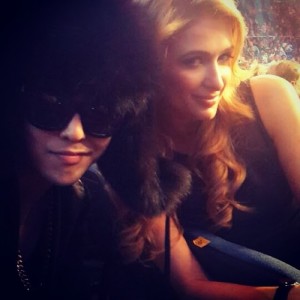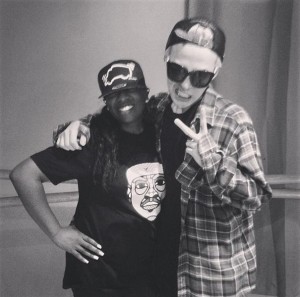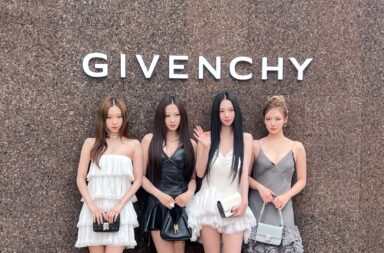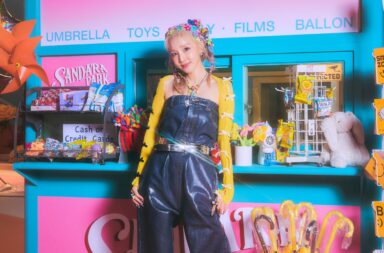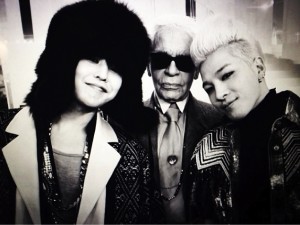 Rihanna recently followed G-Dragon on Instagram. The man has been shown hanging out with Karl Lagerfeld, Justin Bieber, Paris Hilton, and various other influential figures in the Western music and fashion industries, ranging from designers like Thom Browne and Rick Owens to jeweler Ben Baller. Most recently, fellow Big Bang member Taeyang and he were invited to Paris Fashion Week, even landing a mention on The Guardian as “the real global stars of Paris Fashion Week 2014.”
Rihanna recently followed G-Dragon on Instagram. The man has been shown hanging out with Karl Lagerfeld, Justin Bieber, Paris Hilton, and various other influential figures in the Western music and fashion industries, ranging from designers like Thom Browne and Rick Owens to jeweler Ben Baller. Most recently, fellow Big Bang member Taeyang and he were invited to Paris Fashion Week, even landing a mention on The Guardian as “the real global stars of Paris Fashion Week 2014.”
In an industry where even the most obscure foreign poll featuring a K-pop artist is lauded as “Hallyu’s global domination” by the media, it appears that G-Dragon possesses a certain je ne sais quoi that puts him at a different caliber of “world star” than, say, PSY or other veteran K-pop idols who have also made their mark around the globe. Sure, in the K-pop industry itself ,G-Dragon is probably one of the, if not most, well-known fashionista, musician, and entertainers, but what exactly has allowed him to break through the confines of the Korean industry and become recognized by leading brands and figures worldwide?
Just to clarify, world stars do come in a variety of forms. After “Gangnam Style” I think one would be hard-pressed to find someone who has internet access and has not heard of PSY. Even the most casual listeners of K-pop have probably at least heard of Girls’ Generation. Yet, I maintain that G-Dragon has and is doing something unique in building his personal brand name as a K-pop star who is able to effortlessly go back and forth between his idol-dom and his status as a world fashionista, which is only cemented further each passing year as his international profile grows higher.
Which brings me to my main point: G-Dragon’s crossover success may be attributed more to his fashion than his music. Although it seems to run counter to what the rest of K-pop has been doing the past few years in order to hit that breakthrough to achieve crossover success in the US — which is mostly hold a number of concerts in cities like Los Angeles and New York, and the occasional daring English-language single or album release with an American producer’s name on the credits — I daresay it has worked far better for G-Dragon than it has for the rest of K-pop. G-Dragon’s personal style has gained the attention of figures in the Western fashion industry, from Virgil Abloh of Pyrex Vision to Nicola Formichetti (better known as Lady Gaga’s ex-stylist) of Mugler. The former saw that the popularity of Pyrex Vision in Asia increased exponentially after G-Dragon posted a picture of himself in one of its signature flannels on Instagram, and the latter had invited G-Dragon to collaborate with him in producing the music for Mugler’s 2013 F/W menswear show.
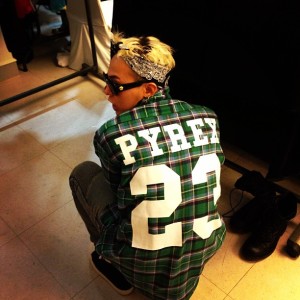 However, it appears that G-Dragon’s growing profile can be attributed more to the power of word of mouth and social media than any deliberate publicity on G-Dragon’s part. CurT@!n$, brand director of label En Noir, has been quoted as saying, “I always saw G-Dragon on Tumblr but never knew who he was.” Yet, people would post pictures of him on Tumblr dressed head to toe in Balmain, Givenchy, or Dior, piquing the interest of tastemakers like CurT@!n$ who admit to having no interest in K-pop or G-Dragon’s music but who later wonders if “maybe [I] should be listening to it.” Of course, on YG Entertainment’s part, the company has not been slacking either. With events like the YG x Chrome Hearts collaboration party, the company is building a brand name and level of overseas recognition that serves as a platform for its artists to gain legitimacy and fame beyond the Hallyu industry.
However, it appears that G-Dragon’s growing profile can be attributed more to the power of word of mouth and social media than any deliberate publicity on G-Dragon’s part. CurT@!n$, brand director of label En Noir, has been quoted as saying, “I always saw G-Dragon on Tumblr but never knew who he was.” Yet, people would post pictures of him on Tumblr dressed head to toe in Balmain, Givenchy, or Dior, piquing the interest of tastemakers like CurT@!n$ who admit to having no interest in K-pop or G-Dragon’s music but who later wonders if “maybe [I] should be listening to it.” Of course, on YG Entertainment’s part, the company has not been slacking either. With events like the YG x Chrome Hearts collaboration party, the company is building a brand name and level of overseas recognition that serves as a platform for its artists to gain legitimacy and fame beyond the Hallyu industry.
This is, in my opinion, what differentiates G-Dragon (and the rest of YG) from the rest of K-pop: the savvy branding that allows G-Dragon and YG to position themselves as the ‘most legitimate possible crossover success in the US’. By infusing G-Dragon’s image with a unique combination of fashion, music, and personality, the image of “G-Dragon” as seen by those outside of Korea is closer to what one expects of an artist-entertainer than the oft-lamented cookie-cutter idols we all love in K-pop. Grimes, one of G-Dragon’s growing number of Western musician fans, praises his “emphasised personality” as a key reason for his ability to cross over from K-pop, as opposed to bands such as SHINee or Girls’ Generation who are “kind of anonymous.”
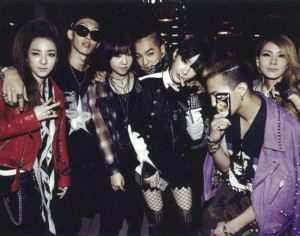
Obviously, there are arguments that rightly point out that YG is merely going for a “lite” imitation of what the Western music industry does, with its too-cool-for-school attitude and creative freedoms that apparently cannot be found anywhere else in K-pop. However, the fact remains that YG is the most visible and obvious example of such a company culture in K-pop, and this culture is precisely what attracts a significant portion of its fanbase to liking and admiring Big Bang and 2NE1.
With the perceived artistic legitimacy that comes with such branding, this affords G-Dragon a self-perpetuating cycle of fame and recognition, as opposed to one-off promotions or even sustained crossover attempts in the US in the style of the Wonder Girls or his own labelmate Se7en. With fame and recognition come more established Western names seeking to collaborate musically with G-Dragon, or at least, be willing to collaborate with G-Dragon if the latter may so ask. Examples include Pixie Lott, who featured both G-Dragon and T.O.P on her track “Dancing on My Own,” Sky Ferreira and Boys Noize in G-Dragon’s latest album Coup D’etat, and of course, the legendary Missy Elliott for the track “Niliria.”
That is not to say that crossover acts like PSY are a failure either — arguably, PSY is even more well-known than G-Dragon, especially after his signing with Scooter Braun’s Schoolboy Records in the US. However, one must also recognise that PSY in himself must be considered the exception, not the rule, in K-pop, and in many ways, his runaway success with “Gangnam Style” is also due to its unwitting adherence to several stereotypes of the “Asian funnyman” (remember William Hung?) that exist in the media.
Even in the case of Rain, his crossover to Hollywood was more as an action star than as a musician; and again, in adherence to the “Asian kung-fu fighter” trope that characterizes a number of famous Asian actors like Bruce Lee or Jackie Chan.
In all, the success of G-Dragon’s branding lies in how he markets himself not as a spoof or gimmick, but as a force to be reckoned with in terms of his music and his personal style. Compared to the “export Hallyu” approach that underpins the majority of K-pop crossover attempts to the US, G-Dragon is selling the image of “G-Dragon” both to the Western fashion and music industries and audience, and it seems to be working for him. Not one to forget his roots as a Big Bang member and as an idol in Korea, G-Dragon himself reflected a much more measured and realistic explanation for his rising star among Western tastemakers in an interview with Complex magazine in September 2013.
“Just to put it real simply, [American tastemakers] are taking notice because I’m doing well. If I didn’t do well, they wouldn’t even have noticed me or cared. So I don’t put too much meaning behind it.”
Is there longevity in G-Dragon the world star? Only time will tell.
(Complex, NME, The Guardian, Images via G-Dragon’s Instagram, Twitter, W Korea, W Magazine)
